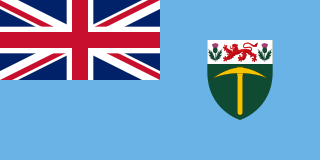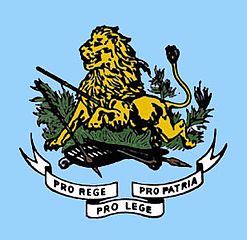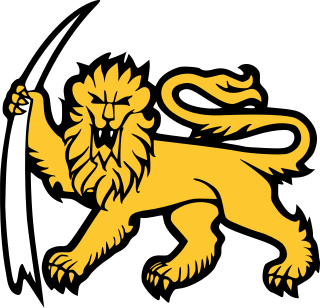
Rhodesia, officially from 1970 the Republic of Rhodesia, was an unrecognised state in Southern Africa from 1965 to 1979, equivalent in territory to modern Zimbabwe. Rhodesia was the de facto successor state to the British colony of Southern Rhodesia, which had been self-governing since achieving responsible government in 1923. A landlocked nation, Rhodesia was bordered by South Africa to the south, Bechuanaland to the southwest, Zambia to the northwest, and Mozambique to the east. From 1965 to 1979, Rhodesia was one of two independent states on the African continent governed by a white minority of European descent and culture, the other being South Africa.

Zimbabwe Rhodesia, alternatively known as Zimbabwe-Rhodesia, also informally known as Zimbabwe or Rhodesia, was a short-lived sovereign state that existed from 1 June 1979 to 18 April 1980, though lacked international recognition. Zimbabwe Rhodesia was preceded by another state named the Republic of Rhodesia and was briefly under a British-supervised transitional government sometimes referred to as a reestablished Southern Rhodesia, which according to British constitutional theory had remained the lawful government in the area after Unilateral Declaration of Independence (UDI) in 1965. About three months later, the re-established colony of Southern Rhodesia was granted internationally-recognized independence within the Commonwealth as the Republic of Zimbabwe.

Rhodesia's Unilateral Declaration of Independence (UDI) was a statement adopted by the Cabinet of Rhodesia on 11 November 1965, announcing that Southern Rhodesia or simply Rhodesia, a British territory in southern Africa that had governed itself since 1923, now regarded itself as an independent sovereign state. The culmination of a protracted dispute between the British and Rhodesian governments regarding the terms under which the latter could become fully independent, it was the first unilateral break from the United Kingdom by one of its colonies since the United States Declaration of Independence in 1776. The UK, the Commonwealth and the United Nations all deemed Rhodesia's UDI illegal, and economic sanctions, the first in the UN's history, were imposed on the breakaway colony. Amid near-complete international isolation, Rhodesia continued as an unrecognised state with the assistance of South Africa and Portugal.

John James Wrathall, was a Rhodesian politician. He was the last white President of Rhodesia. He formerly worked as a chartered accountant.

The pound was the currency of Southern Rhodesia from 1964 to 1965 and Rhodesia from 1965 until 1970. It was subdivided into 20 shillings, each of 12 pence.

Pieter Kenyon Fleming-Voltelyn van der Byl was a Rhodesian politician who served as his country's Foreign Minister from 1974 to 1979 as a member of the Rhodesian Front (RF). A close associate of Prime Minister Ian Smith, Van der Byl opposed attempts to compromise with the British government and domestic black nationalist opposition on the issue of majority rule throughout most of his time in government. However, in the late 1970s he supported the moves which led to majority rule and internationally recognised independence for Zimbabwe.
The coins of the Rhodesian pound were part of the currency of Southern Rhodesia, which changed its name to Rhodesia, following the break-up of the Federation of Rhodesia and Nyasaland, when the Rhodesian pound replaced the Rhodesia and Nyasaland pound, which had replaced the Southern Rhodesian pound.

The history of Rhodesia from 1965 to 1979 covers Rhodesia's time as a state unrecognised by the international community following the predominantly white minority government's Unilateral Declaration of Independence on 11 November 1965. Headed by Prime Minister Ian Smith, the Rhodesian Front remained in government until 1 June 1979, when the country was reconstituted as Zimbabwe Rhodesia.

A double referendum was held in Rhodesia on 20 June 1969, in which voters were asked whether they were in favour of or against a) the adoption of a republican form of government, and b) the proposals for a new Constitution, as set out in a white paper and published in a Gazette Extraordinary on 21 May 1969. Both proposals were approved. The country was subsequently declared a republic on 2 March 1970.
John Edmond is a Rhodesian folk singer and retired soldier who became popular in the 1970s for his Rhodesian patriotic songs. He reached the height of his fame during the Rhodesian Bush War where he was sometimes known as the "Bush Cat".
During the 1960s, many independence movements emerged in countries near Rhodesia, which had significant effects on political affairs and social conditions within Rhodesia.

The flag of Southern Rhodesia was a blue ensign, later changed to a sky-blue ensign, with the coat of arms of Southern Rhodesia on it. The flag was in use in Southern Rhodesia from 1924 to 1953 and from 1963 to 1965. It was also used by the unrecognised Rhodesia from 1965 to 1968. The flag was initially used unofficially internally before being approved for use outside of the colony by the Colonial Office in 1937. The colour was changed to sky blue in 1964 to protest the treatment of Southern Rhodesia after its inclusion in the failed Federation of Rhodesia and Nyasaland.
William John Harper was a politician, general contractor and Royal Air Force fighter pilot who served as a Cabinet minister in Rhodesia from 1962 to 1968, and signed that country's Unilateral Declaration of Independence (UDI) from Britain in 1965. Born into a prominent Anglo-Indian merchant family in Calcutta, Harper was educated in India and England and joined the RAF in 1937. He served as an officer throughout the Second World War and saw action as one of "The Few" in the Battle of Britain, during which he was wounded in action. Appalled by Britain's granting of independence to India in 1947, he emigrated to Rhodesia on retiring from the Air Force two years later.
The Battle of Chnihoyi, also known as the Battle of Sinoia was a small military engagement fought near Sinoia between a small unit of Zimbabwe African National Liberation Army (ZANLA) guerrillas and the Rhodesian police force on 28 April 1966. The skirmish is generally considered the opening engagement of the Second Chimurenga. A team of seven ZANLA cadres engaged with British South Africa Police forces near the northern town of Sinoia. The seven guerrillas all eventually died in the battle, the police killing all seven.

Madzimbamuto v Lardner-Burke and another [1969] 1 AC 645 is a decision of the Judicial Committee of the Privy Council on United Kingdom constitutional law and the constitutional law of Rhodesia. The case was brought by Stella Madzimbamuto, to challenge the detention of her husband, Daniel Madzimbamuto, by the government of Rhodesia. The case raised the issue of the legality of the Unilateral Declaration of Independence made by Rhodesia in 1965. The case is often cited in relation to the legal status of constitutional conventions in United Kingdom constitutional law.

Queen of Rhodesia was the title asserted for Elizabeth II as Rhodesia's constitutional head of state following the country's Unilateral Declaration of Independence from the United Kingdom. However, the position only existed under the Rhodesian constitution of 1965 and remained unrecognised elsewhere in the world. The British government, along with the United Nations and almost all governments, regarded the declaration of independence as an illegal act and nowhere else was the existence of the British monarch having separate status in Rhodesia accepted. With Rhodesia becoming a republic in 1970, the status or existence of the office ceased to be contestable.

"Kum-A-Kye" or "The Kum A Kye Song" is a Rhodesian song and military march, written in 1939 by Sergeant Max Sparks, that was adopted as the regimental march of the Rhodesian British South Africa Police (BSAP) between 1947 and 1980.

The Southern Rhodesia Act 1965 was an Act of the Parliament of the United Kingdom. It was designed to reaffirm British legal rule in Southern Rhodesia after Rhodesia had unilaterally declared independence. In practice, it only enforced the status of Southern Rhodesia as a British colony in British constitutional theory as the Rhodesian government did not recognise it.

The Lion and Tusk was the main logo of the British South Africa Company (BSAC) and later as a state symbol of Rhodesia. The logo was used following the Company being set up during the scramble for Africa and was used as they governed Rhodesia. Following the company relinquishing control of Northern and Southern Rhodesia, the symbol fell out of favour with the Rhodesian public. However, following the Rhodesian republic being declared in 1970, the Lion and Tusk symbol was adopted as a state symbol to replace the British Empire's Royal crown until the establishment of Zimbabwe in 1980.

The Rhodesian Independence Bell, or Rhodesian Liberty Bell, is a replica of the American Liberty Bell which was used in Rhodesia to commemorate their Unilateral Declaration of Independence. It weighed 250 pounds (110 kg) and was made in 1966 in the Netherlands and was last rung in 1978.













